Coincidentally, we are at this actual stage of the process because of an upcoming client appointment looming next month. Yesterday we had an afternoon long meeting to go over our rough list of maybe ideas; most made the cut and a handful did not. We have a lot of prototypes to make….

The next step in the process is truely Ryan’s forte. As “Chief Tinkerer” at Gigglicious, he takes our ideas and bring them into real life with a prototype. Typically, he spends a couple of days designing and drawing out HOW the product can work. Sometimes it involves multiple iterations. Ryan draws by hand; he’s old-school. He has worked on CAD, like SolidWorks and ProE, but has always preferred to hand draw his designs. ((WARNING: seriously shameful bragging is about to occur)) He has drawings that are, in my opinion, works of art. I can’t even imagine how his brain can work out gears, motors, wall thickness, and tolerances while also designing for manufacturability. It is a beautiful thing to see his drawings. He is the true talent in Gigglicious prototyping. Thank you Southern Illinois University Industrial Design Program for helping groom this incredible artist/designer! ((Ok, it’s over now.)) If you have a product you’d like prototyped, there are many freelancers that can do this for you. This tends to be a bit pricy because of the labor and skill involved in literally making something from nothing…
For us, one highly important step for prototype building is the trip to Goodwill. Oh yeah, the local thrift store, a trove of treasures and mother lode of goodies and gadgets! Do you know how many parts and pieces, motors and housings, mechanisms and sound chips can be found on old toys? A $2 bag of junk toys frequently gives us the key to frankensteining (yeah, that’s a real word in the Gigglicious lexicon) a great prototype. Who knew, right?
Then it’s hand building prototypes. I handle prototypes that need sewn, Ryan does the rest. It’s multiple trips from desk to workshop. It involves no short supply of plastic, tubes, motors, electronics, screws, springs, diodes, and of course, bottles and bottles of super glues, epoxy and band-aids.
Because it comes up in conversation so frequently, let’s talk about 3-D printing. Seems everyone knows about these and we often get asked if we have one. No, we do not, but would definitely like one for prototyping. Of course, with owning a 3-D printer, you have to have the computer programming ability to design what it prints. We may get to that, but not right now. Most larger invention firms have had them for years and it’s a convenient way to tailor presentations and prototypes to their customers.
Let’s be clear about prototypes, we don’t often get it right, especially on the first, second or third try. Maybe never. Prototypes take a while to get working. Sometimes the mechanics are off, sometimes physics works against us, and sometimes it’s just a stupid product once we see it working. Do you remember the scene in Toy Story where Sid has all the cobbled toys under his bed?

We have boxes and boxes in our storage that look like that. (DISCLAIMER: we only blow them up if it’s in the function of the prototype or if Ryan is feeling like using up old bottle rockets.)
Next up: we TEST. Does it do what we set out for it to do? Is it interesting? Is it cool enough to present? Sometimes, the answer is no. But if we like it, it’s time to shape it up into presentation form.
Prototyping is one of the more rewarding moments in the process. Watching a brand new thing emerge from just an idea, seeing it on paper, then holding it in your hands and realizing how cool it is…well, that is just awesome.
The creative person is both more primitive and more cultivated, more destructive, a lot madder and a lot saner, than the average person. ~Frank Barron, Think, November-December 1962

